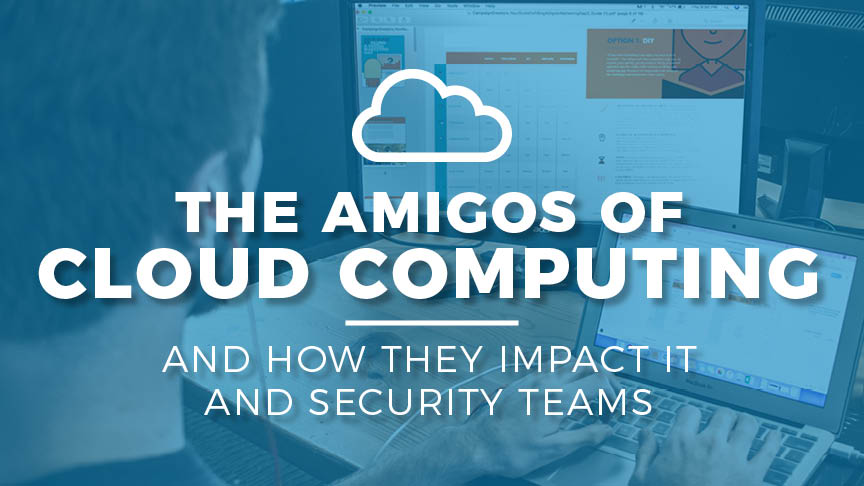Amazon, Microsoft, IBM, Google, and Oracle’s IaaS (Infrastructure as a Service) divisions are growing – how does this impact in-house IT and security?
It’s difficult to go through a typical day at the office without encountering cloud services with every click of the mouse. You checked your email on Office 365 or Gmail? Hello Microsoft Azure and Google Cloud. You Slacked your colleague about this morning’s rollup? Thanks a bunch, Amazon Web Services. You shared some working files of that quarterly report over Dropbox? Thanks Oracle Cloud. Bought that American Airlines ticket for next month’s out-of-state conference? Good effort, IBM Cloud (formerly Bluemix). As our employers have dropped the IT muscle in the server rooms, the bulk of the computational lifting has been happening above our heads.
The five companies mentioned here, Amazon, Microsoft, IBM, Google, and Oracle — also referred to lovingly by “AMIGOs” generally command the landscape of cloud services in addition to other companies both domestic and international like Salesforce, Rackspace, and Alibaba. The growth of cloud computing as a whole is staggering and expected to eclipse $175 billion by early 2019. Gartner predicts that Infrastructure as a Service (IaaS), a smaller but the fastest-growing segment of cloud, will grow 27.6% in 2019 to reach $39.5 billion, up from $31 billion in 2018.
Worldwide Public Cloud Service Revenue Forecast ($ Billions)
| 2017 | 2018 | 2019 | 2020 | 2021 | |
| Cloud Business Process Services (BPaaS) | 42.2 | 46.6 | 50.3 | 54.1 | 58.1 |
| Cloud Application Infrastructure Services (PaaS) | 11.9 | 15.2 | 18.8 | 23.0 | 27.7 |
| Cloud Application Services (SaaS) | 58.8 | 72.2 | 85.1 | 98.9 | 113.1 |
| Cloud Management and Security Services | 8.7 | 10.7 | 12.5 | 14.4 | 16.3 |
| Cloud System Infrastructure Services (IaaS) | 23.6 | 31.0 | 39.5 | 49.9 | 63.0 |
| Total Market | 145.3 | 175.8 | 206.2 | 240.3 | 278.3 |
Rain Clouds?
This major shift to outsourced computing and hardware directly impacts the roles and responsibilities of both IT and cybersecurity staff. Certainly, managing hardware in-house has gotten easier. IT teams spend less time maintaining rows of servers and doing things like swapping out blades and power supplies. Security teams don’t have to worry about putting out nearly as many figurative as well as literal fires.
Yet, where IaaS fills the void for many responsibilities that were once in-house, it creates opportunities and challenges internally to ensure a successful implementation and integration into other systems. In this vein, IT and security teams must have a clear understanding of how cloud services function as well as what risks they present.
In Awe of AWS
Amazon Web Services dominates the cloud infrastructure market with a 33% share and thus deserves the most attention. Even as the aforementioned competition grows stronger year over year, it has not been to the detriment of AWS’s growth trajectory.
Along with the demand for AWS, there is a corollary demand for practitioners with knowledge of AWS. Fortunately, there is a formal set of certifications available to legitimize AWS abilities at three different levels: Associate, Specialty, and Professional. These levels cover a wide range of subjects, skills, and roles all of which are in high demand.
- AWS Certified Developer: This Associate level certification hones in on code-level knowledge of AWS development and maintenance along with a general understanding of AWS architecture.
- AWS Certified Solutions Architect: Practitioners who earn these Associate and Professional level certifications demonstrate knowledge in the design, management, and distribution of applications related to AWS tools. This includes the creation and scalability of AWS systems, in addition to know-how in disaster recovery, security best practices, and troubleshooting.
- AWS Certified SysOps Administrator: As the name suggests, this Associate level certification focuses on the operations or administrative duties. Those who hold this certification have knowledge of AWS architecture, deployment, and data migration.
- AWS Certified DevOps Engineer: This certification is attainable by those who have earned the AWS Certified Developer or AWS Certified SysOps Administrator certification exams and have amassed at least two years of experience provisioning and managing AWS architectures.
- AWS Certified Big Data: This specialty certification requires at least one Associate-level certification and five years of data analytics experience.
- AWS Certified Advanced Networking: This certification demonstrates a keen knowledge of network architecture including design, development, and deployment. Practitioners can earn this certification after earning an Associate level certification and amassing five or more years in data analytics and networking.
The Other ‘MIGOs
While AWS leads the pack, we can’t discount the other players in the space and the certifications that legitimize knowledge in those platforms:
Microsoft Azure
Professionals working with Microsoft Azure can earn role-based certifications in three different areas:
- Microsoft Certified Azure Administrator: This certification is for individuals that maintain, implement, and monitor an Azure cloud.
- Microsoft Certified Azure Developer: This certification is for individuals that develop and implement Azure solutions.
- Microsoft Certified Azure Solutions Architect: This certification is for individuals who design Azure networks, storage, and compute services.
IBM Cloud
In true IBM fashion, there is a certification for every role. Far too many to list in this context, individuals can pursue certifications related to IBM Cloud as Certified Associates, Developers, Professionals, and Advisors. Employers that leverage IBM Cloud may look for employment candidates that have relevant certifications in these hiring areas or, indeed, may fund training to earn additional certifications as a requirement of a job role.
Google Cloud
- Associate Cloud Engineer: This certification shows that an individual has demonstrated the ability to deploy applications, monitor operations, and maintain cloud projects on the Google Cloud Platform.
- Professional Cloud Architect: This credential showcases proficiency to design, build, and manage solutions on the Google Cloud Platform.
- Professional Data Engineer: This certification means achievement in competency to design and build data processing systems and create machine learning models on Google Cloud Platform.
- Professional Cloud Developer [beta]: This credential is designed to demonstrate one’s ability to build and deploy scalable and highly available applications on the Google Cloud Platform.
Oracle Cloud
Oracle offers an associate-level certification for IaaS specific to Oracle Cloud available to all IT professionals.
- Oracle Cloud Infrastructure 2018 Certified Architect Associate: The Oracle Cloud Infrastructure Architect Associate exam is designed for individuals with knowledge in architecting infrastructure using Oracle Cloud Infrastructure services.
Beyond The ‘MIGOs
While many vendors have cloud platform products and certifications, other certification bodies have also added specific cloud offerings to their current credentials. Also, many of their popular certifications often even have objectives that address the cloud.
CompTIA
While CompTIA is most known in the IT certification arena for the A+, Network+, and Security+ certifications, CompTIA released a new cloud certification, Cloud+ (CV0-003). The latest edition of this exam focuses on five main domains: Architecture and Design, Security, Deployment, Operations and Support, and Troubleshooting. Finally, as acknowledgments of an IT professional’s need to understand a bit about cloud, the A+ (Core Exam 1 and Core Exam 2), Network+, and Security+ exams have objectives that covered cloud and virtualization topics.
(ISC)2
Another vendor-neutral certification provider, (ISC)2, best known for its security certifications, launched a cloud security certification, the Certified Cloud Security Professional (CCSP). This exam focuses on six main domains: Architectural Concepts & Design Requirements, Cloud Data Security, Cloud Platform & Infrastructure Security, Cloud Application Security, Operations, and Legal & Compliance.
We All Float On
Since the term “cloud-computing” first appeared in 1996, the technology has been evolving and establishing footholds before shooting up in hockey-stick fashion in recent years. While this presents a change from the mainframe reality of the past, there’s no denying that cloud computing will continue to be a significant aspect of the future of the global enterprise. In reflection of this new reality, IT and security teams must be ready to adapt, commit, and ride these white fluffy clouds into the next decade. For training materials, practice exams, and question banks related to some of the most in-demand cloud certifications, visit our Certify page to explore certifications and foundational courses on the Cloud career track.


